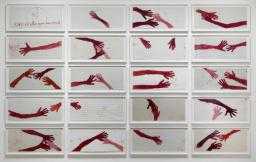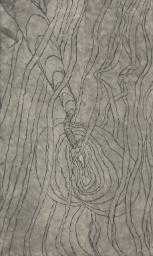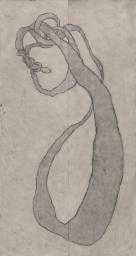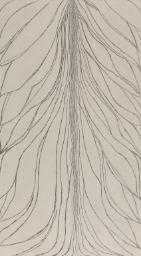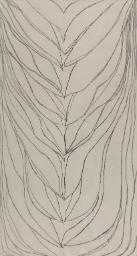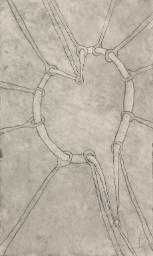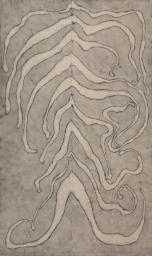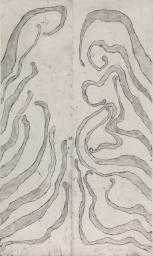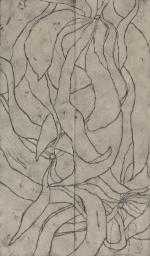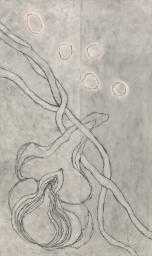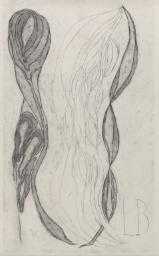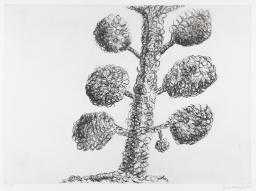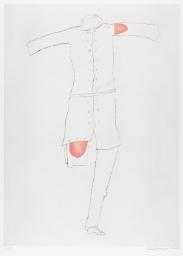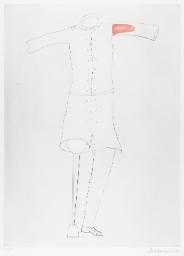
Not on display
- Artist
- Louise Bourgeois 1911–2010
- Medium
- 12 oil-based woodcuts on japanese handmade paper
- Dimensions
- Image, each: 356 × 422 mm
frame, each: 400 × 466 × 38 mm - Collection
- ARTIST ROOMS
Tate and National Galleries of Scotland. Lent by Artist Rooms Foundation 2013
On long term loan - Reference
- AL00346
Summary
Spirals is a suite of twelve oil-based woodcut prints on Japanese paper. The prints are arranged in a grid formation with three rows of four prints. Each print depicts a spiral, with nine of the prints using red ink, two using black ink and one using blue ink. The spirals range in shape and size, with some of the spirals contained within the limits of the paper and others continuing beyond the picture plane. The line of each spiral is also different in each print, varying in thickness, with some more geometric and precise in style and others loose and flowing. The spirals were created by drawing on traditional Japanese printmaking methods and are printed on Japanese paper. The grain from the wood used to produce the prints is clearly visible on the spirals.
The spiral appears frequently in both Bourgeois’s sculpture and her work on paper, including in A l’infini 2008–9 (Tate AL00357), where the spiral is representative of an endless natural cycle. Specifically, the spiral is often used by Bourgeois to represent the constant continuation of birth, life and rebirth, sometimes associated directly with motherhood, as can be seen in Nature Study 1986 (Tate AL00228). Bourgeois explained her repeated return to the imagery of the spiral:
The spiral is important to me. It is a twist. As a child, after washing tapestries in the river, I would turn and twist and ring them … Later I would dream of my father’s mistress. I would do it in my dreams by ringing her neck. The spiral – I love the spiral – represents control and freedom.
(Quoted in Gardner 1994, p.68.)
For Bourgeois the spiral represents the abstract concepts of control and freedom as well as being invested with a personal symbolism. The sense of the artist exerting a level of control over her work is compounded by the decision to display the prints in a grid formation. The use of the grid is also a common feature of Bourgeois’s works on paper and is perhaps a reference to her training in geometry at the Sorbonne, the study of which had a direct impact on her artwork: ‘My minimalism came from my love of geometry. Sometimes it is inherently dynamic: a study of conflicting forces, which is never static’ (quoted in Frances Morris (ed.), Louise Bourgeois, exhibition catalogue, Tate Modern, London 2007, p.148). The use of both free-flowing and precise spiralling lines in Spirals could also be a reference to the duality of control and freedom as described by the artist.
Bourgeois’s use of the colour red in Spirals is another recurring characteristic of her work. The artist often uses the colour to refer to the extremes of human emotion. Bourgeois said: ‘Red is an affirmation at any cost – regardless of the dangers in fighting – of contradiction, of aggression. It’s symbolic of the intensity of the emotions involved’ (quoted in Askew and d’Offay 2013, p.85). In this work the colour red appears most frequently in the twelve prints. However, the colours blue and black also appear. Bourgeois contrasts blue and black in a diary entry of 1986: ‘Nothing can satisfy the need to cover everything in blue. The opposite is in black – black from suicide, a black point, the deep black of a well, the solemnity … That is why blue pinches my heart. It’s a defence, like overeating sugar’ (quoted in Morris 2007, p.83). In her predominant use of red tempered with blue and black, the artist may have been reinforcing the use of the spiral as symbolic of the cyclical nature of life, whereby moments of intense emotion and aggression alternate with periods of contentment, thoughtfulness, depression and solemnity.
Further reading
Paul Gardner, Louise Bourgeois, New York 1994.
Mignon Nixon, Fantastic Reality: Louise Bourgeois and a Story of Modern Art, Cambridge, Massachusetts and London 2005.
Lucy Askew and Anthony d’Offay, Louise Bourgeois: A Woman Without Secrets, exhibition catalogue, National Galleries of Scotland, Edinburgh 2013, p.94, reproduced p.8, pp.58–9.
Allan Madden
University of Edinburgh
November 2015
The University of Edinburgh is a research partner of ARTIST ROOMS.
Does this text contain inaccurate information or language that you feel we should improve or change? We would like to hear from you.
You might like
-
Louise Bourgeois 10 am is When You Come to Me
2006 -
Louise Bourgeois The Nest
2009 -
Louise Bourgeois Turning Inwards
2008 -
Louise Bourgeois The Smell of Eucalyptus (#1)
2006 -
Louise Bourgeois The Smell of Eucalyptus (#2)
2006 -
Louise Bourgeois The Stretch
2006 -
Louise Bourgeois Are You In Orbit? (#1)
2007 -
Louise Bourgeois Are You In Orbit? (#2)
2007 -
Louise Bourgeois Les Fleurs
2007 -
Louise Bourgeois Love and Kisses
2007 -
Louise Bourgeois The Unfolding
2007 -
Louise Bourgeois My Inner Life
2008 -
Louise Bourgeois Tree
1998 -
Louise Bourgeois Amputee
1998 -
Louise Bourgeois Amputee with Peg Leg
1998

